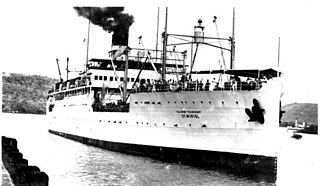
The United States Shipping Board (USSB) was established as an emergency agency by the 1916 Shipping Act, on September 7, 1916. The United States Shipping Board's task was to increase the number of US ships supporting the World War I efforts. United States Shipping Board program ended on March 2, 1934.
SS Cotopaxi was an Emergency Fleet Corporation (EFC) Design 1060 bulk carrier built for the United States Shipping Board (USSB) under the World War I emergency shipbuilding program. The ship, launched 15 November 1918, was named after the Cotopaxi stratovolcano of Ecuador. The ship arrived in Boston, 22 December 1918, to begin operations for the USSB, through 23 December 1919, when Cotopaxi was delivered to the Clinchfield Navigation Company under terms of sale.

St. Mihiel was a troopship built for the United States Shipping Board by the American International Shipbuilding Corporation at Hog Island, Pennsylvania. The ship was operated from 1922 until mid-1940 as USAT St. Mihiel by the Army Transport Service. In July 1941 the ship was transferred to the Navy which commissioned her USS St. Mihiel with the hull number AP-32. In November 1943, she was transferred back to the Army and converted into the hospital ship, USAHS St. Mihiel.

The Design 1013 ship, also known as the Robert Dollar type, was a steel-hulled cargo ship design approved for mass production by the United States Shipping Board's Emergency Fleet Corporation (EFT) in World War I. Like many of the early designs approved by the EFT, the Design 1013 did not originate with the EFT itself but was based on an existing cargo ship design, in this case one developed by the Skinner & Eddy Corporation of Seattle, Washington.

SS Cynthia Olson was a cargo ship originally built in Wisconsin in 1918 as the SS Coquina. Renamed in 1940, in August 1941 she was chartered by the US Army to transport supplies to Hawaii. While in passage between Tacoma, Washington and Honolulu on December 7, she was intercepted by the Japanese submarine I-26, which sank her with gunfire. Although the commander of the submarine ensured that all of the crew had escaped into boats, none of them was ever found. Cynthia Olson was the first United States Merchant Marine vessel to be sunk after the entry of the United States into World War II.
SS Managua was a Nicaraguan Cargo ship that the German submarine U-67 torpedoed on 16 June 1942 in the Straits of Florida while she was travelling from Charleston, South Carolina, United States to Havana, Cuba with a cargo of Potash. The ship was built as Glorieta, a Design 1049 ship in 1919, operated by the United States Shipping Board (USSB) until sold to the Munson Steamship Line in 1920 and renamed Munisla. The ship was sold foreign to a Honduran company, Garcia, in 1937 and renamed Neptuno. In 1941 the ship was re-flagged in Nicaragua with the name Managua.

The Design 1023 ship was a steel-hulled cargo ship design approved for mass production by the United States Shipping Board's (USSB) Emergency Fleet Corporation (EFC) in World War I. Like many of the early designs approved by the EFC, the Design 1023 did not originate with the EFC itself but was based on an existing cargo ship designed by Theodore E. Ferris for the United States Shipping Board (USSB). The ships, to be built by the Submarine Boat Corporation of Newark, New Jersey, were the first to be constructed under a standardized production system worked out by Ferris and approved by the USSB.
SSCapillo was a Design 1022 cargo ship built for the United States Shipping Board immediately after World War I.
Suremico was a Design 1023 cargo ship built for the United States Shipping Board (USSB) immediately after World War I. She was later named the Nisqually and converted into a barge and later a scow. She was bombed and sunk during the Battle of Wake Island.

SS Lake Elsmere was an Emergency Fleet Corporation (EFC) Design 1074 cargo ship built for the United States Shipping Board (USSB) during the massive shipbuilding effort of World War I.
SSNew England was a Design 1023 cargo ship built for the United States Shipping Board immediately after World War I.
SSSuedco was a Design 1023 cargo ship built for the United States Shipping Board immediately after World War I.
SSSuboatco was a Design 1023 cargo ship built for the United States Shipping Board immediately after World War I.
SSSuportco was a Design 1023 cargo ship built for the United States Shipping Board immediately after World War I.
SSKehuku was a Design 1031 tanker ship built for the United States Shipping Board immediately after World War I.
SSMary was a Design 1022 cargo ship built for the United States Shipping Board immediately after World War I.
SSCassimir was a Design 1022 cargo ship built for the United States Shipping Board immediately after World War I.
SSCarrabulle was a Design 1022 cargo ship built for the United States Shipping Board immediately after World War I.
SSCatahoula was a Design 1022 cargo ship built for the United States Shipping Board immediately after World War I.
SSComol Cuba was a Design 1022 cargo ship built for the United States Shipping Board immediately after World War I. Converted to a tanker, she spent most of her career transporting molasses, a byproduct of sugar refining, to the United States. During World War II, she transported petroleum before returning to the private sector.





